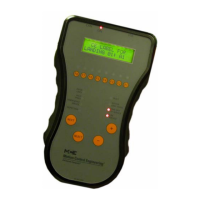F1: Program Mode
5-19
PARKING FLOOR Any landing can be selected to be the parking floor. The car will go to
the parking floor when it is free of call demand. In addition, there is a Parking Delay Timer that
will cause a free car to wait for a short time before parking. The timer is adjustable, with a value
between 0.0 minutes (no delay) and 6.0 minutes (see “PARKING DELAY TIMER” on page 5-
27). If the parking feature is not needed, choose NONE when the Parking Floor option message
is on the display. The car will stay at the last call answered.
ALT. PARKING FLOOR This option is available only when the API input is pro-
grammed and a parking floor is set. Any landing can be selected to be the alternate parking
floor. This car will go to the alternate parking floor when it is free of call demand and the API
input is active.
SECONDARY PARKING FLOOR This option is for duplex systems only. Any landing
can be selected to be the secondary parking floor. The car will go to this floor when it becomes
free of call demand and the other car is already parked at the first parking floor. It is acceptable
to make the secondary parking floor the same as the first parking floor, if both cars are to park
at the same floor. If a second parking floor is not needed, choose NONE when the Secondary
Park Floor option message is on the display. Then, the first free car will go to the first parking
floor, but the second car will stay at the last call answered.
LOBBY FLOOR Any landing can be selected to be the Lobby Floor. When the car answers
either a hall or car call at this floor, the doors will stay open until the Lobby Door Timer elapses
(the Lobby Door Timer is adjustable, see “LOBBY DOOR TIMER” on page 5-26). NOTE: The
Lobby Floor is also used for CTL input.
CAR IDENTIFIER This option is for duplex systems only. Its purpose is to specify which
controller is assigned to car A and which controller is assigned to car B. This is primarily used
for controllers that use a peripheral device such as a CRT.
SERIAL COP BOARD HC-CPI? YES/NO - Yes indicates that the COP signals are being
handled by an HC-CPI Serial COP board and therefore the car calls should not be assigned to
HC-UIO board terminals.
SERIAL COP BOARD TYPE? Set to type of installed serial COP board (HC-CPI, ICE-
COP-2, or NONE.
DISCRETE PI’s on UIO? Set to No if the car uses serial (CE) position indicator fix-
tures. See caution above.
• Set to Yes if PI’s are connected to HC-UIO boards.
DEDICATED PI BOARD? (Appears if “Discrete PI’s on UIO?” is set to Yes. Dedicates
the first one or two HC-UIO boards to PI’s alone [no call connections]).
• If Yes: Position Indicators will be located on UIO Board 0 (zero) for 2 - 16 stops or boards
0 (zero) and 1 (one) for 2 - 32 stops (board 1 handles 17 - 32 [assuming that PI is one wire
per floor]). Calls will begin on a new UIO Board immediately following Board 0 or 1.
• If No: PI’s are located on UIO boards but calls can begin immediately following the last PI
rather than on the next UIO board.
SERIAL CARTOP DOOR CNTRL? YES/NO - Yes indicates that door control is being
handled by an HC-UIO board that is installed on the car top.
DISABLE LOCAL HALL CALLS? Set to Yes if the car is dispatched by a group control-
ler and should not respond to a local (connected to car) riser. If this car has swing operation, do
not set this to Yes as it will prevent the car from responding to local riser calls.

